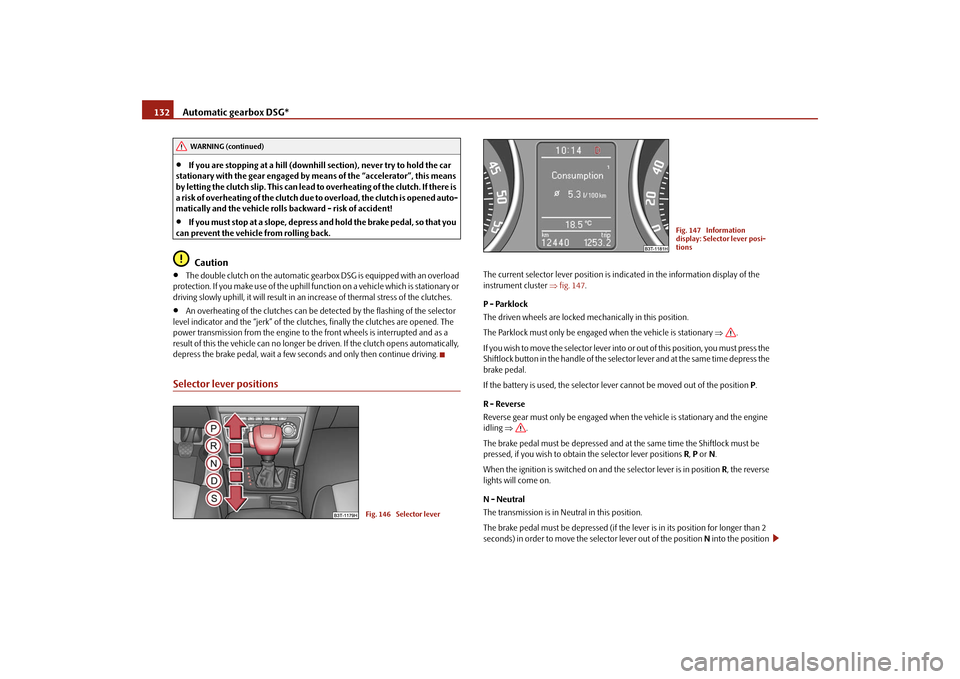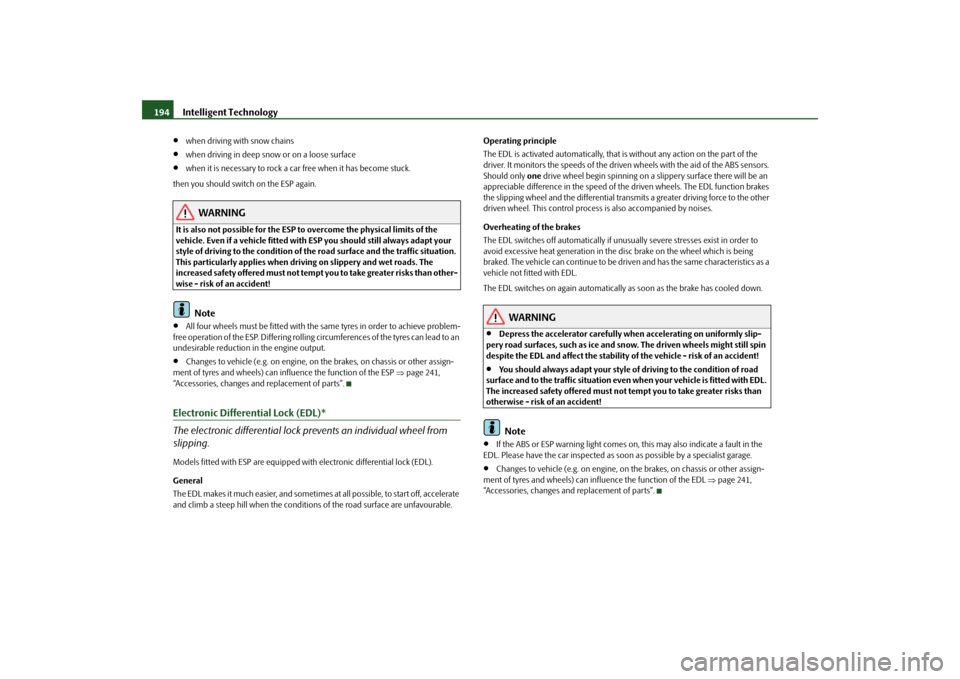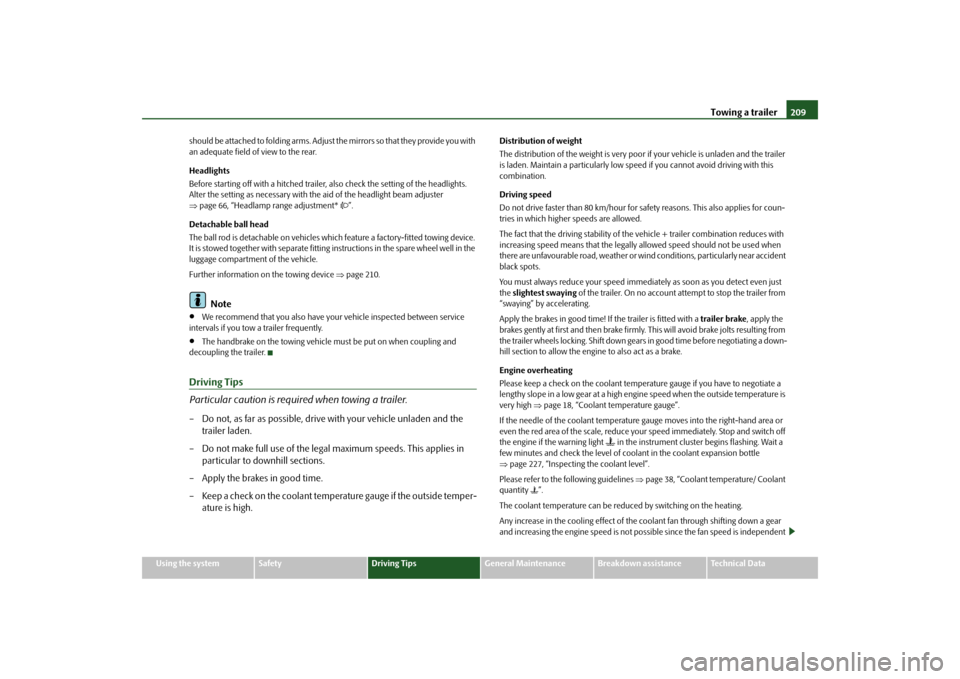engine overheat SKODA SUPERB 2009 2.G / (B6/3T) Owner's Manual
[x] Cancel search | Manufacturer: SKODA, Model Year: 2009, Model line: SUPERB, Model: SKODA SUPERB 2009 2.G / (B6/3T)Pages: 294, PDF Size: 21.33 MB
Page 133 of 294

Automatic gearbox DSG*
132
•
If you are stopping at a hill (downhill section), never try to hold the car
stationary with the gear engaged by me
ans of the “accelerator”, this means
by letting the clutch slip. This can lead
to overheating of the
clutch. If there is
a risk of overheating of the clutch due
to overload, the clut
ch is opened auto-
matically and the vehicle rolls backward - risk of accident!•
If you must stop at a slope, depress
and hold the brake pedal, so that you
can prevent the vehicle from rolling back.
Caution
•
The double clutch on the automatic gear
box DSG is equipped with an overload
protection. If you make use of the uphill func
tion on a vehicle which is stationary or
driving slowly uphill, it will result in an
increase of thermal stress of the clutches.
•
An overheating of the clutches can be de
tected by the flashing of the selector
level indicator and the “jerk” of the clut
ches, finally the clutches are opened. The
power transmission from the engine to the front wheels is interrupted and as a result of this the vehicle can no longer be
driven. If the clutch opens automatically,
depress the brake pedal, wait a few se
conds and only then continue driving.
Selector lever positions
The current selector lever position is indicated in the information display of the instrument cluster
⇒fig. 147
.
P - Parklock The driven wheels are locked mechanically in this position. The Parklock must only be engage
d when the vehicle is stationary
⇒
.
I f y o u w i s h t o m o v e t h e s e l e c t o r l e v e r i n to
or out of this position, you must press the
Shiftlock button in the handle of the selector lever and at the same time depress the brake pedal. If the battery is used, the selector leve
r cannot be moved out of the position
P.
R - Reverse Reverse gear must only be engaged when
the vehicle is stationary and the engine
idling
⇒
.
The brake pedal must be depressed and at the same time the Shiftlock must be pressed, if you wish to obtain the selector lever positions
R, P or N.
When the ignition is switched on and the selector lever is in position
R, the reverse
lights will come on. N - Neutral The transmission is in Neutral in this position. The brake pedal must be depressed (if the lever is in its position for longer than 2 seconds) in order to move the selector lever out of the position
N into the position
WARNING (continued)
Fig. 146 Selector lever
Fig. 147 Information display: Selector lever posi-tions
s2dk.1.book Page 132 Wednesday, April 8, 2009 12:23 PM
Page 195 of 294

Intelligent Technology
194
•
when driving with snow chains
•
when driving in deep snow or on a loose surface
•
when it is necessary to rock a ca
r free when it has become stuck.
then you should switch on the ESP again.
WARNING
It is also not possible for the ESP to overcome the physical limits of the vehicle. Even if a vehicle fitted with ESP you should still always adapt your style of driving to the condition of the
road surface and the traffic situation.
This particularly applies when driving on slippery and wet roads. The increased safety offered must not tempt you to take greater risks than other- wise - risk of an accident!
Note
•
All four wheels must be fitted with the same tyres in order to achieve problem-
free operation of the ESP. Differing rolling
circumferences of the tyres can lead to an
undesirable reduction in the engine output.•
Changes to vehicle (e.g. on engine, on the brakes, on chassis or other assign-
ment of tyres and wheels) can influence the function of the ESP
⇒page 241,
“Accessories, changes and replacement of parts”.Electronic Differential Lock (EDL)* The electronic differential lock pr
events an individual wheel from
slipping.Models fitted with ESP are equipped with electronic differential lock (EDL). General The EDL makes it much easier, and sometimes at all possible, to start off, accelerate and climb a steep hill when the conditio
ns of the road surface are unfavourable.
Operating principle The EDL is activated automatically, that is
without any action on the part of the
driver. It monitors the speeds of the driven wheels with the aid of the ABS sensors. Should only
one
drive wheel begin spinning on a slippery surface there will be an
appreciable difference in the speed of the driven wheels. The EDL function brakes the slipping wheel and the differential transmits a greater driving force to the other driven wheel. This control proces
s is also accompanied by noises.
Overheating of the brakes The EDL switches off
automatically if unusually severe
stresses exist in order to
avoid excessive heat generation in the
disc brake on the wheel which is being
braked. The vehicle can continue to be driv
en and has the same characteristics as a
vehicle not fitted with EDL. The EDL switches on again
automatically as soon as the brake has cooled down.
WARNING
•
Depress the accelerator carefully when accelerating on uniformly slip-
pery road surfaces, such as ice and sn
ow. The driven wheels might still spin
despite the EDL and affect the stability
of the vehicle - risk of an accident!
•
You should always adapt your style of driving to the condition of road
surface and to the traffic situation even
when your vehicle is fitted with EDL.
The increased safety offered must not tempt you to take greater risks than otherwise - risk of an accident!
Note
•
If the ABS or ESP warning light comes on,
this may also indicate a fault in the
EDL. Please have the car inspected as s
oon as possible by a specialist garage.
•
Changes to vehicle (e.g. on engine, on
the brakes, on chassis or other assign-
ment of tyres and wheels) can in
fluence the function of the EDL
⇒page 241,
“Accessories, changes and
replacement of parts”.
s2dk.1.book Page 194 Wednesday, April 8, 2009 12:23 PM
Page 210 of 294

Towing a trailer
209
Using the system
Safety
Driving Tips
General Maintenance
Breakdown assistance
Technical Data
should be attached to folding arms. Adjust
the mirrors so that they provide you with
an adequate field of view to the rear. Headlights Before starting off with a hitched trailer, also check the setting of the headlights. Alter the setting as necessary with th
e aid of the headlight beam adjuster
⇒ page 66, “Headlamp range adjustment*
”.
Detachable ball head The ball rod is detachable on vehicles which feature a factory-fitted towing device. It is stowed together with separate fitting instructions in the spare wheel well in the luggage compartment of the vehicle. Further information on the towing device
⇒page 210.
Note
•
We recommend that you also have yo
ur vehicle inspected between service
intervals if you tow a trailer frequently.•
The handbrake on the towing vehicle
must be put on when coupling and
decoupling the trailer.Driving Tips Particular caution is required when towing a trailer.– Do not, as far as possible, drive
with your vehicle unladen and the
trailer laden.
– Do not make full use of the legal maximum speeds. This applies in
particular to downhill sections.
– Apply the brakes in good time.– Keep a check on the coolant temper
ature gauge if the outside temper-
ature is high.
Distribution of weight The distribution of the weight is very poor
if your vehicle is
unladen and the trailer
is laden. Maintain a particularly low speed if you cannot avoid driving with this combination. Driving speed Do not drive faster than 80 km/hour for safety reasons. This also applies for coun- tries in which higher speeds are allowed. The fact that the driving stability of the vehicle + trailer combination reduces with increasing speed means that the legally allowed speed should not be used when there are unfavourable road, weather or wind
conditions, particul
arly near accident
black spots. You must always reduce your speed immedi
ately as soon as you detect even just
the
slightest swaying
of the trailer. On no account attempt to stop the trailer from
“swaying” by
accelerating.
Apply the brakes in good time! If the trailer is fitted with a
trailer brake
, apply the
brakes gently at first and then brake firmly
. This will avoid brake jolts resulting from
the trailer wheels locking. Shift down gears
in good time before negotiating a down-
hill section to allow the engine to also act as a brake. Engine overheating Please keep a check on the coolant temperature gauge if you have to negotiate a lengthy slope in a low gear at a high engine speed when the outside temperature is very high
⇒page 18, “Coolant temperature gauge”.
If the needle of the coolant temperature gauge moves into the right-hand area or even the red area of the scale, reduce yo
ur speed immediately. Stop and switch off
the engine if the warning light
in the instrument cluste
r begins flashing. Wait a
few minutes and check the level of coolant in the coolant expansion bottle ⇒ page 227, “Inspecting the coolant level”. Please refer to the following guidelines
⇒page 38, “Coolant temperature/ Coolant
quantity
”.
The coolant temperature can be reduced by switching on the heating.Any increase in the cooling effect of the coolant fan through shifting down a gear and increasing the engine speed is not possible since the fan speed is independent
s2dk.1.book Page 209 Wednesday, April 8, 2009 12:23 PM
Page 222 of 294

Fuel
221
Using the system
Safety
Driving Tips
General Maintenance
Breakdown assistance
Technical Data
Closing fuel filler cap – Screw on the fuel filler cap by turning it to the right until it is heard to
click.
– Close the fuel filler flap until it locks.The correct grade of fuel for your vehicle as
well as the tyre size and inflation pres-
sures are stated on a sticker affixed to the
inside of the fuel filler flap. Further infor-
mation on fuel
⇒page 219.
The fuel tank has a capacity of about 60 litres.
WARNING
Pay attention to any legal requirements if
you do carry a spare canister in the
vehicle. We do not recommend carrying any fuel canisters in your vehicle for safety reasons. The canister can be da
maged in the event of an accident and
fuel may leak out.
Caution
•
Before refuelling it is necessary to switch off the auxiliary heating system (auxil-
iary heating and ventilation) *.•
Remove any fuel which has spilled onto the paintwork of your vehicle immedi-
ately - risk of paint damage!•
Vehicles fitted with catalytic converter sh
ould never be allowed to let the fuel
tank to run completely empty. An irregular
supply of fuel to the engine can result in
misfiring and unburnt fuel may get into the exhaust system, which may result in overheating and damage to the catalytic converter.•
Make sure that the valve is not pressed into the filler tube when inserting the
pump nozzle into the filler tube. Otherwis
e you are unintentionally filling up the
volume, which in case of heat can cause an
expansion of the fuel. This can lead to
an overflow of fuel or damage
to parts of the fuel reservoir.
•
T h e f u e l t a n k i s f u l l j u s t a s s o o n a s t h
e pump nozzle switches off for the first time,
provided the nozzle has been operated properly. Do not continue refuelling - otherwise the expansion volume is filled up.
s2dk.1.book Page 221 Wednesday, April 8, 2009 12:23 PM